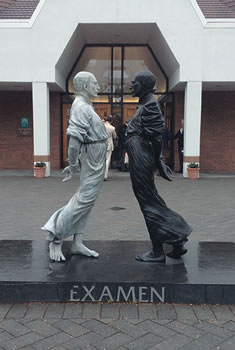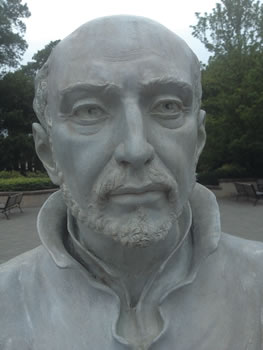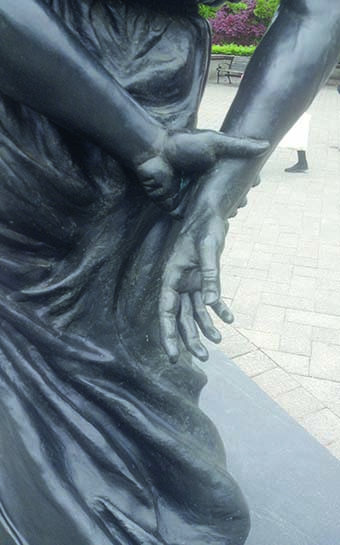Using the Silence
“To promote active participation, the people should be encouraged to take part by means of acclamations, responses, psalms, antiphons, hymns as well as by actions, gestures and bodily attitudes. And at the proper time a reverent silence should be observed” - Sacrosanctum Concilium 30
This month’s column is sparked by a statue which I saw outside the chapel of a Jesuit university in the United States. 
The sculpture was made in 2011 by the husband and wife artistic team of Jeremy Leichman and Joan Benefiel. In a sense it is two statues, both of St Ignatius, yet they are identical apart from one being of a light-coloured bronze the other of a dark. They show him apparently in motion, one foot lifting from the ground ready to step forward. His hands are clasped behind his back, and his sleeves are rolled up. He looks like the man of action he was, very thoroughly an apostolic religious – engaged in the world rather than living a cloistered life. In this dynamic moment he is confronted with himself and he gazes deeply into his own eyes.
 On the plinth is the word ‘Examen’ and the artwork is obviously a reflection on an ancient spiritual practice which Ignatius made an integral part of Jesuit life.
On the plinth is the word ‘Examen’ and the artwork is obviously a reflection on an ancient spiritual practice which Ignatius made an integral part of Jesuit life.
The Examen is a technique of prayerful pondering on the events of the day in order to detect God’s presence and discern his direction for us. Some people have found this a helpful activity for the times of silence in liturgy especially the time after communion.
In his Spirtual Exercises, Ignatius gives a method for the Examen in five points.
The first point is to give thanks to God our Lord for the gifts received. So become aware of the presence of God and express gratitude for all that he has done and is doing in your life.
The second point is to ask for the grace to know my sins and to root them out.
Ask for illumination, light and guidance in looking at your life, help to recognize and correct faults.
The third point is to demand an account of my soul from the moment of rising to that of the present examination, hour by hour or period by period. The thoughts should be examined first, then the words, and finally the actions.
Here is the heart of the Examen, a prayerful reflection on the motivations, words and deeds of the day. Looking steadily, and with God’s help, at what has been driving what I have been doing. Reflecting on myself – something the sculpture shows quite literally. Ignatius is gazing at himself like a general reviewing his troops. It is not a negative regard, but it is acute. He is not going to be fooled.
When I showed photos of the sculpture to Fr Brian Prendeville, a priest with a love for Ignatian spirituality, he pointed out the hand clasped behind the back and said “That is his sword-arm that he is holding. He is deliberately not being defensive.”
The fourth point is to ask pardon of God our Lord for my faults. For when I acted out of self-seeking or any kind of mean spirit, I ask for forgiveness.
The fifth point is to resolve to amend with the help of God’s grace. Close with the Lord’s Prayer.
The Examen is intended to change the one who engages in it. When you look at your motives and do not like the spirit you are acting from, then you want to be different in future. Promise to yourself and to God that you will avoid that mistake. Then offer it all to God in the prayer that Jesus taught.
The reverent silence after reception of the eucharist is a wonderful chance to be in the presence of God and to let the graces of that moment transform one’s life

 Entries(RSS)
Entries(RSS)